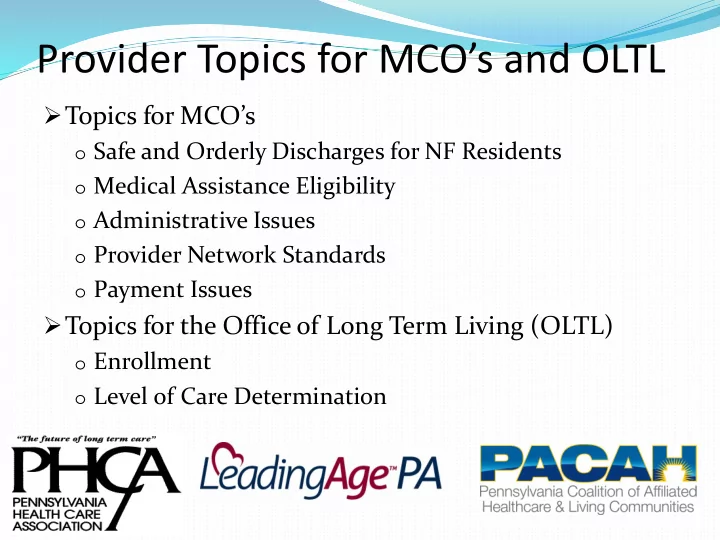

Provider Topics for MCO’s and OLTL Topics for MCO’s o Safe and Orderly Discharges for NF Residents o Medical Assistance Eligibility o Administrative Issues o Provider Network Standards o Payment Issues Topics for the Office of Long Term Living (OLTL) o Enrollment o Level of Care Determination
Safe & Orderly Discharges of Nursing Facility Residents
Safe and Orderly Discharges Care Transition protocols must be consistent with state and federal requirements. NFs responsible for assuring safe & appropriate discharge. How will resolution be obtained when CHC-MCOs want a discharge but resident/family or state entities might not? Safeguards must be in place to minimize unnecessary re-hospitalization of NF residents.
Safe and Orderly Discharges What is the ongoing role of Ombudsman in the CHC discharge process? What is the ongoing role of Nursing Home Transition staff in the CHC discharge process?
Medical Assistance (MA) Eligibility
MA Eligibility Coordination between the County Assistance Office (CAO), Level of Care (LOC) entity, MCO and provider must occur. MA pending—who is at risk – MCO, State or Provider? Initial determinations must be processed timely Redetermination process needs to be coordinated with families, MCOs and providers. Timely appeals Eligibility and authorization processes and requirements must be uniform, streamlined, and coordinated
Administrative Issues
Provider Credentialing Credentialing should be consistent across all CHC-MCOs Maximize the use of Federal and State Medicare and Medicaid participation requirements, as well as any other provider accreditation requirements to avoid redundancies/duplication
CHC-MCO Transfers Clear and well-defined process for the transfer of consumers between CHC-MCOs Safeguards for the continuity of care and payment for out-of-network providers due to transfers Consistent process/procedures for transfers across all CHC-MCOs Established timeframes for transitions Timely notification to providers of changes Deadlines for care management staff assignments
Reporting Requirements Avoid duplicative reporting requirements The State, CHC-MCOs, and providers need to o work together to limit the redundancy of requirements to report incidents and the incidents/definitions of what is to be reported. Recognition of different reporting o requirements for different provider types must be made clear to the CHC-MCOs.
Provider Network Standards
Provider Network Standards Consistent standards across all CHC-MCOs Requirements placed on providers by CHC-MCOs must be consistent with existing state and federal laws and regulations. Additional provider requirements and failure to streamline processes will take resources away from care and services. Providers must be assured of payments if a consumer chooses an out-of-network provider.
Provider Network Standards Assisted Living Residences & Personal Care Homes The role of assisted living residence and personal care homes in CHC must be defined. The impact of the CMS Home and Community- Based Services (HCBS) characteristics and settings final rule on the inclusion of ALR/PCH must be understood and communicated.
Payment Issues
Sufficient Rates to Ensure Quality Care Rates for all long term services and support providers must be adequate so that participants continue to receive quality care. NF Rates must include recognition of all payments that NF providers currently receive including supplemental payments funded by the provider assessment. CHC-MCOs must recognize the costs for various types of individuals including those needing short post- acute stays and those needing long stays.
Timely and Accurate Payment is Critical Current FFS requirements serve as the floor o Pay 90% of clean claims within 30 days o Pay 99% of clean claims within 90 days Accuracy of payments is essential to avoid costly appeals
Provider Issues for OLTL
Provider Issues for OLTL CHC Participant Enrollment Process A flow chart that outlines the steps, timeframes for approval, and entity at risk for the provision of services during each step of the process should be provided. Providers must be trained/educated on the enrollment and selection process in order to effectively assist residents and family members. Extensive coordination between the Department of Human Services (DHS), the provider and the MCO is imperative.
Provider Issues for OLTL Level of Care Determination Will the Level of Care tool be developed and tested in time for Phase I of CHC? Will the new tool be phased-in by region or implemented across the state? How will the Department ensure consistent application of the level of care tool across the state?
Discussion and Questions We look forward to working with OLTL and the CHC- MCOs to implement a smooth transition to this new system for Pennsylvania’s seniors. Contact information: o LeadingAge PA – Anne Henry, Sr VP & Chief Government Affairs Officer – anne@leadingagepa.org o Pennsylvania Health Care Association (PHCA)- Russ McDaid, Present & rmcdaid@phca.org o Pennsylvania Association of County Affiliated Homes (PACAH) -Kelly Andrisano, J.D., Executive Director, kandrisano@pacounties.org
Recommend
More recommend